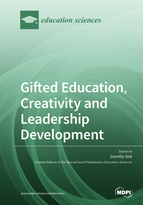Gifted Education, Creativity and Leadership Development
A special issue of Education Sciences (ISSN 2227-7102). This special issue belongs to the section "Special and Inclusive Education".
Deadline for manuscript submissions: closed (30 November 2021) | Viewed by 46527
Special Issue Editor
Special Issue Information
Dear Colleagues,
The issue's overall focus is on an interdisciplinary international exploration of new perspectives to strengthen creativity, giftedness, and leadership. The scope will include an examination of the effect of strength-based pedagogy with gifted and talented students, and the effect of cultivating exceptional talent by integrating knowledge, creativity, innovation, and wisdom in solving 21st century problems. The linking of creativity, giftedness, and leadership through transformation of giftedness will be discussed, as well as the importance of the individual’s urge to lead. The issue will use a double-pronged approach including an examination of recognizing the international contributions of 21st-century views of giftedness and instruction, as well as the effect of mindfulness practices in developing leadership. This issue will be useful for teachers, administrators, psychologists, and gifted individuals in building an understanding of creativity, giftedness, and leadership. In addition, this issue will supplement the SAGE Handbook on Gifted (2018) by providing a more in-depth examination of the triumvirate of creativity, giftedness, and leadership.
Dr. Dorothy Sisk
Guest Editor
Manuscript Submission Information
Manuscripts should be submitted online at www.mdpi.com by registering and logging in to this website. Once you are registered, click here to go to the submission form. Manuscripts can be submitted until the deadline. All submissions that pass pre-check are peer-reviewed. Accepted papers will be published continuously in the journal (as soon as accepted) and will be listed together on the special issue website. Research articles, review articles as well as short communications are invited. For planned papers, a title and short abstract (about 100 words) can be sent to the Editorial Office for announcement on this website.
Submitted manuscripts should not have been published previously, nor be under consideration for publication elsewhere (except conference proceedings papers). All manuscripts are thoroughly refereed through a double-blind peer-review process. A guide for authors and other relevant information for submission of manuscripts is available on the Instructions for Authors page. Education Sciences is an international peer-reviewed open access monthly journal published by MDPI.
Please visit the Instructions for Authors page before submitting a manuscript. The Article Processing Charge (APC) for publication in this open access journal is 1800 CHF (Swiss Francs). Submitted papers should be well formatted and use good English. Authors may use MDPI's English editing service prior to publication or during author revisions.
Keywords
- creativity
- giftedness
- leadership
- mindfulness
- transformation






